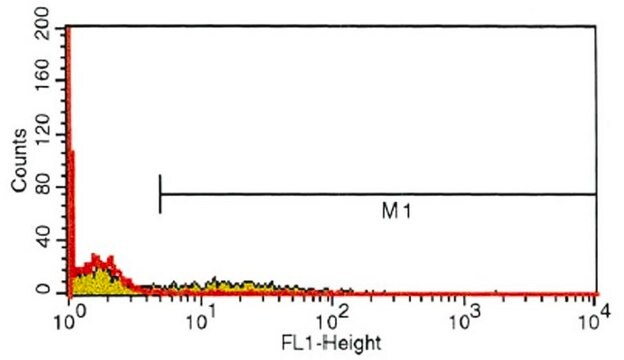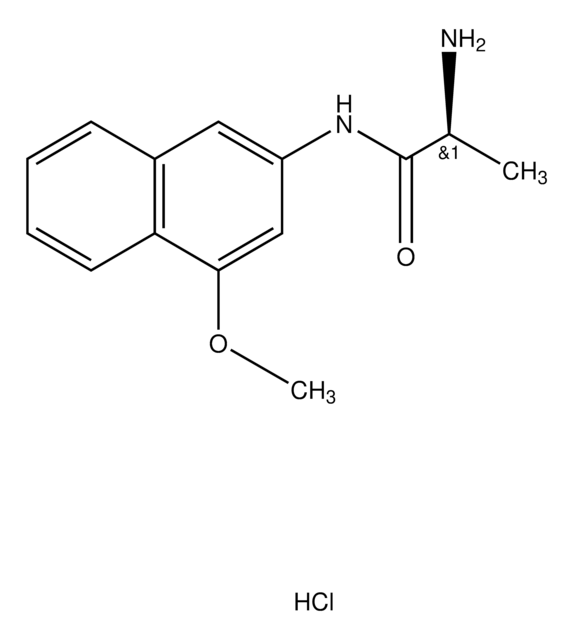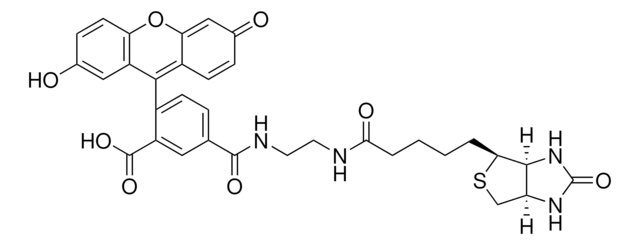推薦產品
生物源
human
重組細胞
expressed in E. coli
描述
0.1 mg recombinant human CHD14 in 20 mM Tris-HCl buffer, containing NaCl, KCl, EDTA, L-arginine, DTT and glycerol.
無菌
Filtered sterilized solution
化驗
≥90% (SDS-PAGE)
形狀
liquid
包裝
pkg of 100 μg
濃度
0.5 mg protein/mL
技術
cell culture | mammalian: suitable
登錄號
NP_000582
運輸包裝
dry ice
儲存溫度
−20°C
基因資訊
human ... CD14(929)
應用
Coating a plate well (6 well plate) with this recombinant CD14 protein in a T cell specific medium at 1-10 μg / well can be used as 1) a human T cell / receptor interaction studies in vitro or 2) a breast cancer biomarker for diagnosis application when combined with CD16 antigen.
Use this procedure as a guideline to determine optimal coating conditions for the culture system of choice.
1. Thaw CD14 and dilute to desired concentration using serum-free medium or PBS. The final solution should be sufficiently dilute so the volume added covers the surface evenly (1-10 μg/well, 6 well plate).
2. Add appropriate amount of diluted material to culture surface.
3. Incubate at room temperature for approximately 1.5 hours.
4. Aspirate remaining material.
5. Rinse plates carefully with water and avoid scratching bottom surface of plates.
6. Plates are ready for use. They may also be stored at 2-8 °C damp or air dried if sterility is maintained.
Use this procedure as a guideline to determine optimal coating conditions for the culture system of choice.
1. Thaw CD14 and dilute to desired concentration using serum-free medium or PBS. The final solution should be sufficiently dilute so the volume added covers the surface evenly (1-10 μg/well, 6 well plate).
2. Add appropriate amount of diluted material to culture surface.
3. Incubate at room temperature for approximately 1.5 hours.
4. Aspirate remaining material.
5. Rinse plates carefully with water and avoid scratching bottom surface of plates.
6. Plates are ready for use. They may also be stored at 2-8 °C damp or air dried if sterility is maintained.
序列
MASMTGGQQMGRGHHHHHHGNLYFQGTTPEPCELDDEDFRCVCNFSEPQPDWSEAFQCVSAVEVEIHAGGLNLEPFLKRVDADADPRQYADTVKALRVRRLTVGAAQVPAQLLVGALRVLAYSRLKELTLEDLKITGTMPPLPLEATGLALSSLRLRNVSWATGRSWLAELQQWLKPGLKVLSIAQAHSPAFSCEQVRAFPALTSLDLSDNPGLGERGLMAALCPHKFPAIQNLALRNTGMETPTGVCAALAAAGVQPHSLDLSHNSLRATVNPSAPRCMWSSALNSLNLSFAGLEQVPKGLPAKLRVLDLSCNRLNRAPQPDELPEVDNLTLDGNPFLVPGTALPHEGSMN
準備報告
The full-length extracellular domain of the human CD14 gene (20-345 aa) was constructed with 29 N-terminal T7/HIS-tag and expressed in E. coli as inclusion bodies. The final product was refolded using our unique “temperature shift inclusion body refolding” technology and chromatographically purified.
儲存類別代碼
10 - Combustible liquids
水污染物質分類(WGK)
WGK 2
閃點(°F)
Not applicable
閃點(°C)
Not applicable
分析證明 (COA)
輸入產品批次/批號來搜索 分析證明 (COA)。在產品’s標籤上找到批次和批號,寫有 ‘Lot’或‘Batch’.。
Denise C Cornelius et al.
PloS one, 15(6), e0234039-e0234039 (2020-06-20)
Sepsis is characterized by organ dysfunction due to a dysregulated immune response to infection. Currently, no effective treatment for sepsis exists. Platelets are recognized as mediators of the immune response and may be a potential therapeutic target for the treatment
R R Schumann et al.
Science (New York, N.Y.), 249(4975), 1429-1431 (1990-09-21)
The primary structure of lipopolysaccharide binding protein (LBP), a trace plasma protein that binds to the lipid A moiety of bacterial lipopolysaccharides (LPSs), was deduced by sequencing cloned complementary DNA. LBP shares sequence identity with another LPS binding protein found
Pengyu Zhang et al.
Naunyn-Schmiedeberg's archives of pharmacology, 391(12), 1411-1420 (2018-08-30)
Label-free cell phenotypic assays were performed to establish a β2-adrenoceptor (β2-AR) target model in A431 cells and a β1-AR target model in transfected HEK293-β1 cells, using known β2-AR and β1-AR agonists and antagonists. A list of natural compounds was screened
Li Fang et al.
PloS one, 9(7), e101406-e101406 (2014-07-16)
LPS-binding protein (LBP) and its ligand CD14 are located upstream of the signaling pathway for LPS-induced inflammation. Blocking LBP and CD14 binding might prevent LPS-induced inflammation. In previous studies, we obtained a peptide analog (MP12) for the LBP/CD14 binding site
A-L Feng et al.
Clinical and experimental immunology, 164(1), 57-65 (2011-03-03)
Human peripheral blood monocytes are a heterogeneous population, including CD14(+) CD16(-) 'classical' monocytes and CD14(+) CD16(+) 'proinflammatory' monocytes. CD16(+) monocytes are expanded in various inflammatory conditions. However, little is known about the CD14(+) CD16(+) monocytes in patients with breast cancer.
我們的科學家團隊在所有研究領域都有豐富的經驗,包括生命科學、材料科學、化學合成、色譜、分析等.
聯絡技術服務








